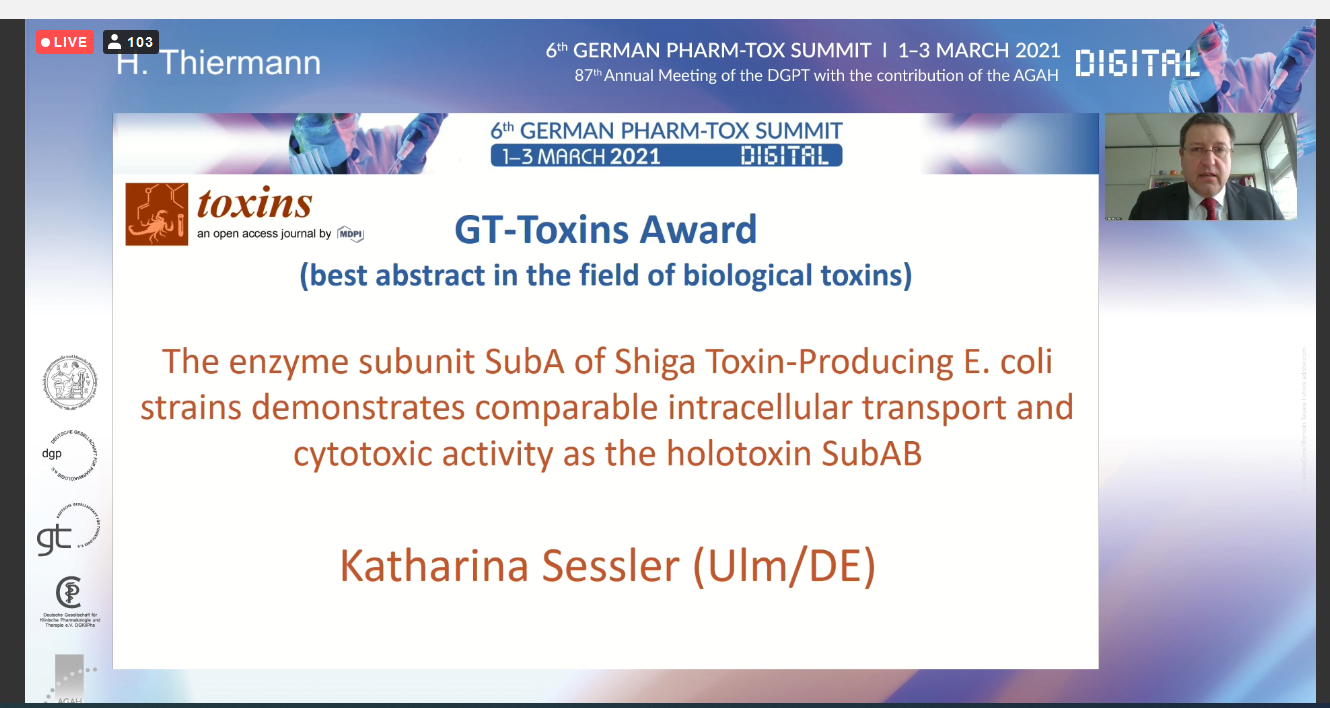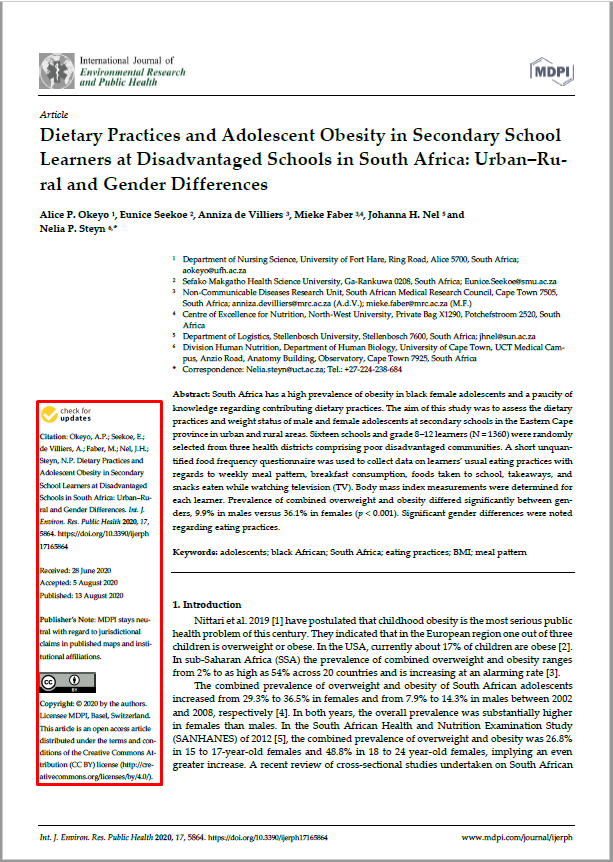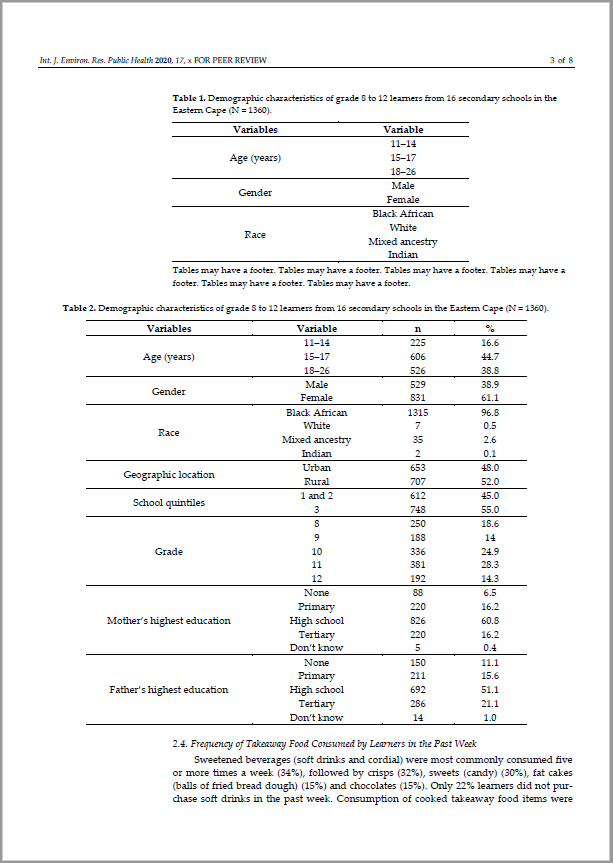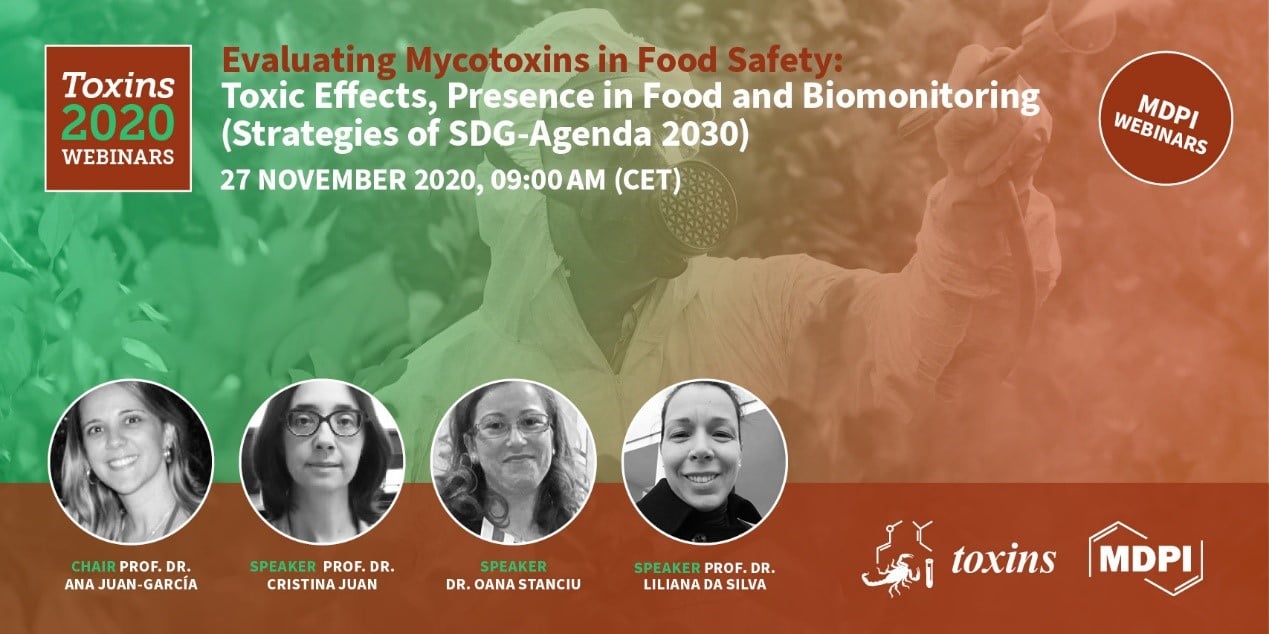
Journal Menu
► ▼ Journal Menu-
- Toxins Home
- Aims & Scope
- Editorial Board
- Reviewer Board
- Topical Advisory Panel
- Instructions for Authors
- Special Issues
- Topics
- Sections & Collections
- Article Processing Charge
- Indexing & Archiving
- Editor’s Choice Articles
- Most Cited & Viewed
- Journal Statistics
- Journal History
- Journal Awards
- Society Collaborations
- Conferences
- Editorial Office
Journal Browser
► ▼ Journal BrowserNeed Help?
Announcements
31 March 2021
Welcoming New Members to the Editorial Board of Toxins
We welcome the following 34 recognized researchers, who recently joined the Editorial Board of Toxins:
Prof. Dr. Matthew P. Rowe, University of Oklahoma, USA
Dr. Siro Luvisetto, Institute of Biochemistry and Cell Biology (IBBC), National Research Council (CNR) of Italy, Italy
Dr. Juan C. Blanco, Marine Research Centre (CIMA), Spain
Prof. Dr. Christine Edwards, Robert Gordon University, UK
Dr. Lorena Tuchscherr, Institute of Medical Microbiology, Germany
Dr. Antonia Susca, Institute of Science of Food Production (ISPA), National Research Council (CNR), Italy
Dr. Houda Berrada Ramdani, Universitat de València (UV), Spain
Dr. Alicia Rodríguez, University of Extremadura, Spain
Prof. Federica Cheli, Coordinating Research Centres (CRC) – Innovation for well-being and Environment (I-WE) - Università degli Studi di Milano, Italy
Dr. Zbigniew Adamski, Adam Mickiewicz University, Poland
Prof. Dr. Sophie Liabeuf, UPJV University, France
Dr. Francesco Giansanti, University of L’Aquila, Italy
Dr. Massimo Bortolotti, Alma Mater Studiorum—University of Bologna, Italy
Dr. Emiko Sato, Tohoku University, Japan
Prof. Dr. Andrea Bolognesi, University of Bologna, Italy
Dr. Fabrizio Anniballi, Department of Food Safety, Nutrition and Veterinary Public Health, Italy
Dr. Bruno Goud, Department of Cell Biology and Cancer (UMR CNRS 144), Institut Curie, France
Dr. Laurent Marsollier, French Institute of Health and Medical Research, France
Prof. Dr. Antonella Giannantoni, University of Siena, Azienda Ospedaliero-Universitaria Santa Maria alle Scotte, Italy
Prof. Dr. Andrea Santamato, Riuniti Hospital, University of Foggia, Italy
Dr. Christina Schroeder, National Cancer Institute, National Institutes of Health, USA
Dr. Jeroen Kool, Division of BioAnalytical Chemistry, Amsterdam Institute of Molecular and Life Sciences, The Netherlands
Dr. Sandra Sousa, Institute for Molecular and Cell Biology, Portugal
Dr. Florence Richard-Forget, INRAE, UR 1264 MycSA Mycologie et Sécurité des Aliments. Centre de recherche Nouvelle-Aquitaine-Bordeaux, France
Prof. Ren Lai, Kunming Institute of Zoology, Chinese Academy of Sciences, China
Prof. Dr. Ligang Zhou, China Agricultural University, China
Prof. Dr. Yidong Wu, Nanjing Agricultural University, China
Dr. Peter A. Keyel, Texas Tech University, USA
Prof. Dr. Moo-Seung Lee, Korea University of Science and Technology, Korea
Dr. Stéphanie Simon, Université Paris-Saclay, CEA, INRAE, Département Médicaments et Technologies pour la santé, France
Prof. Dr. José Miguel Ferreras, Department of Biochemistry, Molecular Biology and Physiology, Faculty of Sciences, University of Valladolid, Spain
Prof. Dr. Lucía Citores, Department of Biochemistry, Molecular Biology and Physiology, Faculty of Sciences, University of Valladolid, Spain
Prof. Dr. Sofia N. Chulze, Research Institute on Mycology and Mycotoxicology (IMICO), National Scientific and Technological Research Council from Argentina (CONICET), Universidad Nacional de Río Cuarto (UNRC), Argentina
Prof. Dr. Daniel Gillet, Section of Molecular Engineering for Health (SIMoS), JOLIOT, CEA, Université Paris-Saclay, France
Further details about the Editorial Board can be found at: https://www.mdpi.com/journal/toxins/editors.
17 March 2021
Toxins | Congratulations to GT-Toxins Award Winner at the 6th German Pharm-Tox Summit, Digital, 2021
The Editorial Team of Toxins would like to congratulate the winner of the GT-Toxins Award, Katharina Sessler, at the 6th German Pharm-Tox Summit.

Here is the title and abstract of her work:
The Enzyme Subunit SubA of Shiga Toxin-Producing E. coli Strains Demonstrates Comparable Intracellular Transport and Cytotoxic Activity as the Holotoxin SubAB
K. Sessler 1, P. Papatheodorou 1, F. Wondany 2, M. Krause 3, S. Noettger 1, D. Bernhard 3, J. Michaelis 2, H. Schmidt 3, H. Barth 11 University Ulm Medical Center, Institute of Pharmacology and Toxicology, Ulm, Germany
2 University Ulm, Institute of Biophysics, Ulm, Germany
3 University of Hohenheim, Institute of Food Science and Biotechnology, Hohenheim, Germany
Shiga toxin-producing Escherichia coli (STEC) strains are bacterial pathogens, which are mainly found in the gastrointestinal tract of farm and wildlife animals. The bacteria can be transmitted to humans via food and causes diarrheal and extraintestinal diseases. In addition to the Shiga toxin, some STEC strains also produce a second toxin, namely the subtilase cytotoxin (SubAB) [1]. SubAB belongs to the family of AB5 toxins, consisting of an enzymatically active A subunit (SubA) and separate B subunits (SubB), which mediate cell binding and uptake of SubAB. Inside the host cell, SubAB is transported via a retrograde pathway into the endoplasmic reticulum (ER), where it cleaves the glucose-regulated protein GRP78. SubAB-induced GRP78 cleavage activates a cellular stress response eventually resulting in cell death [1]. We previously demonstrated that SubA, without SubB, binds and intoxicates HeLa cells [2], whereas the cellular and molecular mechanisms behind this remained unclear. In the present study, we found that even in the absence of SubB, SubA is internalized into cells, reaches the endoplasmic reticulum (ER) and cleaves the chaperone GRP78. Furthermore, SubA-induced GRP78 cleavage in cells is prevented by the pre-treatment of cells with brefeldin A (BFA), which inhibits the transport of protein toxins into the ER. Obviously, SubA contains a yet undescribed ER localization signal, predicted by the software scanProsite™ as a SEEL motif at the C-terminus. Hence, a SubA mutant, lacking the SEEL motif (SubAΔC344), was generated, which exhibited no cytotoxicity alone, but only together with SubB, when tested on HeLa and HCT116 cells. Fluorescence microscopy revealed that SubAΔC344 is generally taken up into cells, but further investigations regarding substrate cleavage have shown that SubAΔC344-induced GRP78 cleavage was delayed when compared to wildtype SubA. We therefore assume that the SEEL motif plays a crucial role in guiding SubA into the ER [3]. Furthermore, we confirmed our findings in the human intestinal mini-gut organoid system. Our results not only contribute to a better understanding of the mode of action of the subtilase cytotoxin, but also raise the question whether a B component-independent cytotoxic effect of the A component is also true for other bacterial AB5 toxins.
- Paton AW et al. (2010), Toxins (Basel) 2(2):215–228.
- Funk J et al. (2015), Infect Immun 83(6):2338–2349.
- Sessler K et al. (2021); Arch. Toxicol. (in press)
10 March 2021
Journal Selector: Helping to Find the Right MDPI Journal for Your Article
At MDPI, we strive to make your online publication process seamless and efficient. To achieve this, our team is continuously developing tools and features to make the user experience useful and convenient.
As the number of academic papers continues to grow, so does the need to analyze and work with them on a large scale. This prompted us to design a new feature aimed at helping researchers find journals that are relevant to their publication by matching their abstract topic. In this regard, we designed a similarity model that automatically identifies the most suitable academic journals for your paper.
We are pleased to introduce Journal Selector, a new feature that measures similarity in academic contexts. By simply entering the title and/or abstract into our Journal Selector, the author will see a list of the most related scientific journals published by MDPI. This method helps authors select the correct journals for their papers, highlighting the time of publication and citability.
The methodology is known as representation learning, where words are represented as vectors in hyperspace. Representation helps us differentiate between different concepts within articles, and in turn, helps us identify similarities between them.
We used an advanced machine learning model to better capture the semantic meanings of words. This helps the algorithm make better predictions by leveraging scientific text representation. In turn, this ensures high precision, helping authors decide which journal they should submit their paper to.
The goal is to support authors to publish their work in the most suitable journal for their research, as fast as possible, accelerating their career progress.
Contact: Andrea Perlato, Head of Data Analytics, MDPI (email)
5 March 2021
Toxins | 2020 Outstanding Reviewer Award—Winners Announced
We are pleased to announce the winners of the Toxins 2020 Outstanding Reviewer Award. The Toxins Editorial Board and Editorial Team would like to gratefully acknowledge the time and energy dedicated by reviewers to checking the manuscripts submitted to Toxins. It is due to their efforts that the high quality of the journal and quick turnaround is maintained.
The following awardees have been selected by the Editor-in-Chief of Toxins, Prof. Dr. Jay W. Fox. Each of them will receive a customized gift and a certificate to recognize their outstanding work:
Dr. Kirill S. Antonets
Affiliation: Laboratory for Proteomics of Supra-Organismal Systems, All-Russia Research Institute for Agricultural Microbiology (ARRIAM), Saint Petersburg, Russia.
Faculty of Biology, St. Petersburg State University (SPbSU), Saint Petersburg, Russia.
Research Interests: bioinformatics; structural biology; bacterial genomics; transcriptomics; molecular biology of host–pathogen interactions
"I would like to thank the Toxins Editorial Board for this Award and for their efforts in providing fast, convenient and transparent processing of manuscripts and reviews."
Dr. Alberto Rico-Yuste
Affiliation: Department of Analytical Chemistry, Complutense University of Madrid, Madrid, Spain.
Research Interests: molecular imprinted polymers; optical chemosensors; food analysis; mycotoxins; spectroscopy; fluorescence
“First of all, I would like to thank the committee for considering me worthy of this award. I consider that reviewing articles is an important part of scientific work.At the same time that it helps to improve the quality of the journals and of the articles that appear in them, it allows to increase the critical capacity of the reviewer. In addition, it is a way to learn and broaden one's knowledge. The publication of an article is the result of a lot of work and I believe that it is everyone's job that their contribution to the scientific society has more weight. That is why I must also thank my mentors for instilling in me the importance of carrying out this type of review with great professionalism and thoroughness.”
For more information about Toxins awards, please see the following link: https://www.mdpi.com/journal/toxins/awards.
24 December 2020
Welcoming New Members to the Editorial Board of Toxins
It is our pleasure to welcome the following 3 recognized researchers, who recently joined the Editorial Board of Toxins:
Prof. Dr. Aibo Wu
CAS Key Laboratory of Nutrition, Metabolism and Food Safety, Shanghai Institute of Nutrition and Health, Chinese Academy of Sciences
Interests: mycotoxins; microbial molecular biology; fungal biology; molecular microbiology
Prof. Dr. Michael Richardson
Institute of Biology Leiden, Leiden University
Interests: evo-devo; reptiles; evolution; chick embryo
Prof. Dr. Yukako Fujinaga
Department of Bacteriology, Kanazawa University
Interests: Clostridium botulinum; botulinum toxin; clostridial neurotoxins
We look forward to their contributions to the journal.
15 December 2020
MDPI adopts C4DISC principles to improve diversity and inclusion in scholarly communications
MDPI is proud to adopt the principles of the Coalition for Diversity & Inclusion in Scholarly Communications (C4DISC) to support building equity, inclusion, diversity, and accessibility in scholarly communications.
The C4DISC represents organizations and individuals working in scholarly communications and is focused on addressing issues of diversity and inclusion within the publishing industry.
MDPI’s Managing Editors encourage the Editors-in-Chief and Associate Editors to appoint diverse expert Editorial Boards. This is also reflective in our multi-national and inclusive workplace. We are proud to create equal opportunities without regard to gender, ethnicity, geographic location, sexual orientation, age, disability, political beliefs, religion, or socio-economic status. There is no place for discrimination in our workplace and editors of MDPI journals are to uphold these principles in high regard.
Representatives from C4DISC meet monthly, and have started to implement initiatives to shed light and improve on the lack of diversity in scholarly communications. Some of the initiatives include developing a joint statement of principles; conducting market research; providing training resources, best practices, toolkits, and documentation for our collective memberships; and establishing outreach programs, curricula, events, and publications.
The Coalition is committed to:
- eliminating barriers to participation, extending equitable opportunities across all stakeholders, and ensuring that our practices and policies promote equitable treatment and do not allow, condone, or result in discrimination;
- creating and maintaining an environment that respects diverse traditions, heritages, and experiences;
- promoting diversity in all staff, volunteers, and audiences, including full participation in programs, policy formulation, and decision-making;
- raising awareness about career opportunities in our industries to groups who are currently underrepresented in the workforce;
- supporting our members in achieving diversity and inclusion within their organizations.
14 December 2020
Article Layout and Templates Revised for Future Volumes
At MDPI we have slightly revised the layout for articles to be published in the 2021 Volume, starting at the end of December 2020. As of today, the article templates available for download on ‘Instructions for Authors’ pages have been updated.
The most noticeable change can be found on the first page of the article, where a left-hand column has been created to include the following front matter elements: (i) the recommended citation style for the article, (ii) the publishing history, (iii) as well as the Creative Commons Attribution license used (iv) a standard note regarding affiliations. At the same time, the extra spacing on the left means the authors’ affiliations are now more clearly set apart than before. Other front matter key elements such as journal logo, article type, article title, authors, abstract and keywords remain unchanged.
The blank column on the left runs through all pages in an article; as a result, the main text is slightly more condensed, which improve reader friendliness for smaller screens. Small figures/tables are aligned on the left with standard indenture, while large figures/tables are centered and covering the full width of the page. The revised layout was applied in the article pictured below, to serve as an example:

1) Information is displayed in the left information bar.

2) In the main text, there is a blank column on the left.

3) Small tables/figures are aligned on the left, large tables/figures are centered.
11 December 2020
2020 "Highly Cited Researchers" on MDPI Journal's Editorial Boards
We are pleased to acknowledge that many academic editors who have made an impact on MDPI journals as editorial board members, editors-in-chief, or section editors, are recognized as 2020 Highly Cited Researchers by Clarivate.
Highly Cited Researchers highlights the top 1% of researchers, by citations, in one or more of the 22 fields used in Clarivate Analytics Essential Science Indicators. We offer our congratulations to 279 academic editors of MDPI journals who were recognized as the most influential scholars in their fields in 2020.
Adams, Dave Agarwal, Ravi P. Ahn, Choon Ki Ahn, Myung-Ju Albrecht, Randy A. Andersson, Dan I. Anker, Stefan D. Apergis, Nicholas Ariga, Katsuhiko Artaxo, Paulo Balsamo, Gianpaolo Barba, Francisco J. Benediktsson, Jon Atli Benelli, Giovanni Bhatnagar, Amit Bialystok, Ellen Blaabjerg, Frede Blay, Jean-Yves Bogers, Marcel Bolton, Declan J. Boyer, Cyrille Brocca, Luca Bruix, Jordi Buhalis, Dimitrios Burdick, Jason A. Byrd, John C. Cabeza, Luisa F. Cabrerizo-Lorite, Francisco Javier Cai, Jianchao Calhoun, Vince D. Cantu, Robert C. Cerqueira, Miguel Chang, Jo-Shu Chau, Kwok-wing Chemat, Farid Chen, Jianmin Chen, Jun Chen, Min Chen, Shaowei Chen, Wei Chen, Wei-Hsin Chen, Xiaofeng Chen, Yangkang Chen, Zhi-Gang Chiclana, Francisco Corella, Dolores Cortes, Javier Cortes, Jorge Cummings, Kenneth Michael Dai, Shifeng Decker, Eric A. DePinho, Ronald A. Dimopoulos, Meletios-Athanasios Dincer, Ibrahim Du, Yihong Dupont, Didier Edwards, David Ellahi, Rahmat Ellis, Erle C. ElMasry, Gamal Esteller, Manel Estruch, Ramón Fang, Chuanglin Fasano, Alessio Fernandez-Lafuente, Roberto Ferreira, Isabel Fortino, Giancarlo Galluzzi, Lorenzo Galvano, Fabio Gandomi, Amir H. Gandomi, Amir H. Gao, Bin Gao, Feng Gao, Wei Garbe, Claus García, Hermenegildo Geschwind, Daniel H. Giampieri, Francesca Giralt, Sergio A. Glanz, Karen Goldewijk, Kees Klein Gössling, Stefan Govindan, Kannan Granato, Daniel Grosso, Giuseppe Grosso, Giuseppe Guerrero, Josep M. Haase, Dagmar Hagger, Martin S. Hamblin, Michael R. Han, Heesup Jankovic, Joseph Janotti, Anderson |
Jiang, Hai-Long Kalaji, Hazem M. Kalantar-Zadeh, Kourosh Kaner, Richard B. Karimi, Hamid Reza Kataoka, Kazunori Keesstra, Saskia Kepp, Oliver Kerminen, Veli-Matti Keyzers, Robert A. Khademhosseini, Ali Khan, Nafees A. Kim, Ki-Hyun Klemeš, Jiří Jaromír Klenk, Hans-Peter Konopleva, Marina Y. Krammer, Florian Krebs, Frederik C. Kroemer, Guido Kudo, Masatoshi Kurths, Juergen Kurzrock, Razelle Kuznetsov, Nikolay V. Kyrpides, Nikos C. La Vecchia, Carlo Lai, Yuekun Lam, James Lancellotti, Patrizio Lee, Sangmoon Leung, Victor C. M. Li, Jinghong Li, Yurui Lindahl, José M. Merigó Lip, Gregory Y. H. Loh, Xian Jun Long, Hualou Lund, Henrik Luo, Jingshan Luque, Rafael Lyons, Timothy W. Ma, Jun Ma, Wen-Xiu Ma, Yanming Maeda, Keisuke Makarova, Kira Mantovani, Alberto Martín-Belloso, Olga Martinoia, Enrico Marzband, Mousa Masclaux-Daubresse, Celine Masson, Patrick Mateos, María Victoria Mathiesen, Brian Vad Matyjaszewski, Krzysztof McArthur, Grant A. McCauley, Darren Medlock, Jolyon M. Melero, Ignacio Mezzetti, Bruno Miroshnichenko, Andrey E. Moran, Daniel Mueller, Lukas A. Mueller-Roeber, Bernd Naushad, Mu Nemeroff, Charles B. Nieto, Juan J. O'Donnell, Colm Ogino, Shuji Olabi, Abdul-Ghani O'Regan, Donal Orsini, Nicola Oswald, Isabelle P. Ozcan, Aydogan Pahl-Wostl, Claudia Pang, Huan Payne, James E. Peng, Shushi Perc, Matjaz Perez-Alvarez, Jose Angel Piquero, Alex R. Ploss, Alexander Postolache, Mihai Pradhan, Biswajeet Prinsep, Michele R. Qian, Dong Qu, Xiaogang Reiter, Russel J. Riahi, Keywan Richter, Andreas Rignot, Eric Robert, Caroline Ros, Emilio Rosell, Rafael |
Rosen, Marc A. |
The full list of 2020 Highly Cited Researchers can be accessed on https://recognition.webofsciencegroup.com/awards/highly-cited/2020/
--- Highly Cited Researchers (HCR) is a Clarivate product.
19 November 2020
Toxins Series Webinars: Join us for our two webinars on November 26th and 27th

In this webinar, we will present some examples of fungal phytotoxins that could be used as potential bioherbicides and of phytotoxins produced by pathogenic fungi of agrarian plants. Furthermore, the importance of the absolute configuration assignment and the main methodology used for its determination will be presented as well as some examples of their total synthesis.
Chair: Marco Masi
Date: 26th November 2020
Time: 1:00pm CET | 6:00am CST
Webinar ID: 984 7644 1392
Register for Free Here: https://sciforum.net/conference/Toxins-1

This webinar will project the SDGs of Agenda 2030 by presenting some examples of natural antioxidants present in food that can alleviate the effects of mycotoxins in vitro, the study of the increased presence of mycotoxins in wheat associated with climate change, and the results obtained in biomonitoring mycotoxins in children’s urine.
Date: 27 November 2020
Time: 9:00am CET | 2:00am CST | 4:00pm UTC+8
Chair: Ana Juan- García
Webinar ID: 886 5296 8196
Register for Free Here: https://sciforum.net/conference/Toxins-2
For any questions about the webinar, please send an email to toxins.webinar@mdpi.com
28 September 2020
Welcoming New Members to the Editorial Board of Toxins
We welcome the following 7 recognized researchers, who recently joined the Editorial Board of Toxins:
Dr. Shinichiro Kurosawa, Boston University School of Medicine, USA
Prof. Dr. Somshuvra Mukhopadhyay, The University of Texas at Austin, USA
Prof. Dr. Philippe Guerre, Université de Toulouse, France
Prof. Dr. Ketan Patel, University of Reading, United Kingdom
Prof. Dr. Ketan Patel, University of Reading, United Kingdom
Dr. Thérèse Malliavin, Institut Pasteur and CNRS UMR 3528, Unité de Bioinformatique Structurale, France
Dr. Félix Núñez, Universidad de Extremadura, Unité de Bioinformatique Structurale, Spain
We look forward to their contributions to the journal.
Toxins Editorial Office





